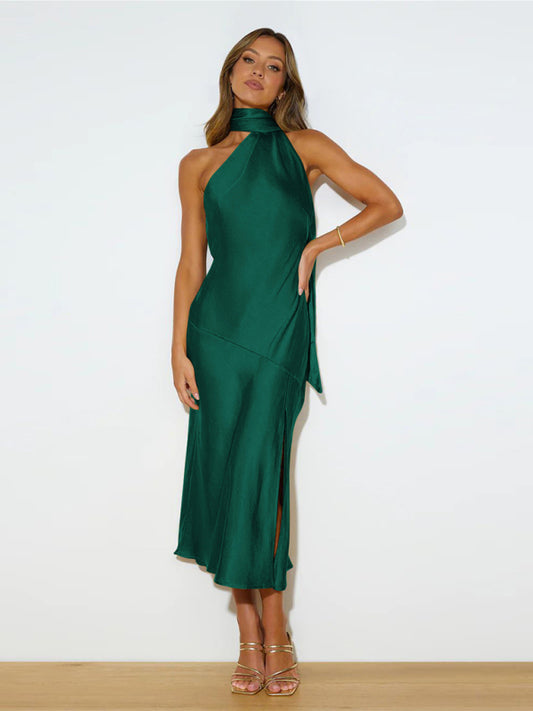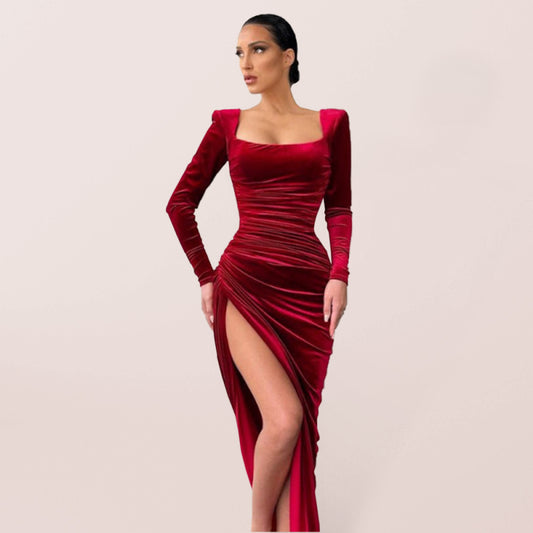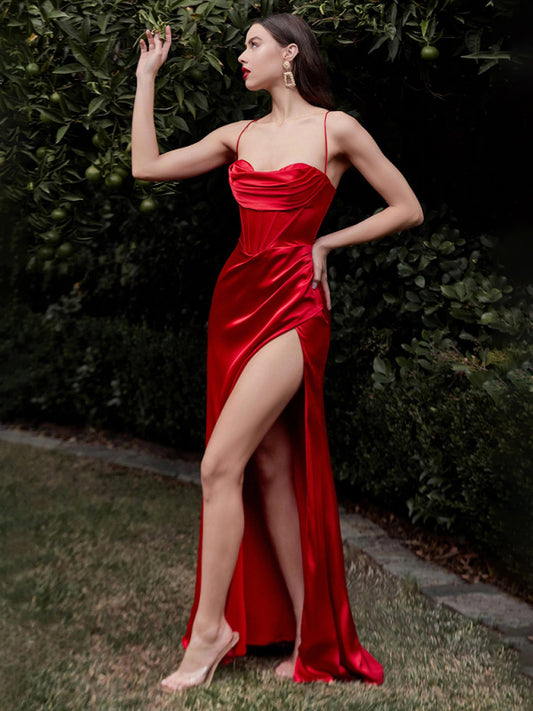Ball Gowns
-
Elegant evening gown strapless sexy long dress
Regular price $98.02 USDRegular priceUnit price / per$147.55 USDSale price $98.02 USDSale -
Party Evening Gown Strapless Elegant Dress
Regular price $95.28 USDRegular priceUnit price / per$190.99 USDSale price $95.28 USDSale -
Moonlit Muse Cut-Out Gown Maxi Dress
Regular price $163.49 USDRegular priceUnit price / per$326.99 USDSale price $163.49 USDSale -
Blue Zone Planet | Tara's Strapless Mesh Evening Gown Mini Dress
Regular price $60.00 USDRegular priceUnit price / per$92.24 USDSale price $60.00 USDSale -
Celestial Bloom One-Shoulder Gown Maxi Dresses
Regular price $83.00 USDRegular priceUnit price / per$128.22 USDSale price $83.00 USDSale -
Blue Zone Planet | French Elegant Long Sleeve Evening Gown Gold Velvet Dress
Regular price $70.00 USDRegular priceUnit price / per$103.60 USDSale price $70.00 USDSale -
Blue Zone Planet | Linda's Satin Slit Backless Evening Gown Midi Dress
Regular price $55.00 USDRegular priceUnit price / per$83.96 USDSale price $55.00 USDSale -
Blue Zone Planet | Plus size deep V waist dress sexy velvet ball gown dress
Regular price $73.00 USDRegular priceUnit price / per$110.65 USDSale price $73.00 USDSale -
Blue Zone Planet | Ladies Square Neck High Waist Split Mini Gown Dress
Regular price $42.00 USDRegular priceUnit price / per$62.77 USDSale price $42.00 USDSale -
Sexy Sleeveless Strap Chest Pleated Gown Dress
Regular price $50.00 USDRegular priceUnit price / per$70.00 USDSale price $50.00 USDSale -
Glitter Evening Gown Floor Length Dresses
Regular price $56.00 USDRegular priceUnit price / per
Collection: Ball Gowns
The resurgence of the grand silhouette: why the Ball Gown still rules the room
There are dresses that attend an event, and dresses that create one. The true ball gown—the cloud of tulle or satin, the cinched waist, the sweep of miles-wide skirt—does not simply accompany its wearer through a doorway; it alters the doorway’s proportions, reframes the evening, and coaxes even jaded onlookers into remembering what glamour feels like. In an era that celebrates athleisure and utility pockets, why has this most theatrical of silhouettes staged a return? The answer lies in equal parts psychology, technology, and the simple need for occasions larger than life.
Step onto any 2025 red carpet, quinceañera dance floor, TikTok prom reveal, or charity gala and the pattern is unmistakable: full skirts billowing like inverted tulips, bodices molded to perfection, trains that whisper across polished marble. Social feeds loop slow-motion spins; influencers chart “radius checks” to see how many friends disappear beneath the hem. Yet this is not nostalgia for Cinderella alone. Modern ball gowns are feats of engineering that balance spectacle with surprising practicality. Lightweight crinolines and hoop-less petticoats fashioned from layered organza create volume without the medieval scaffolding. Built-in bustier support frees wearers from complicated underpinnings, while side-seam pockets—yes, pockets—quietly host a phone and lipstick.
Sociologists sometimes describe fashion as a barometer of collective mood. By that measure, the ball gown’s bloom signals a desire for optimism after years of global uncertainty. Weddings postponed in the early 2020s have morphed into “mega-weddings,” and couples choose attire that matches the scale of celebration. Teens whose early adolescence took place in video-conference windows now want prom moments that exist in three dimensions and wide angles. Even corporate fund-raisers cast fairy-tale themes, inviting executives to trade tailored minimalism for a night of maximalist fantasy.
While couture houses once monopolized the silhouette, democratization is well underway. Mid-range fashion labels offer modular gowns: bodices that attach to skirts via discreet zippers, allowing a single garment to shift from ball-room amplitude to after-party column. Rental platforms stock watercolor-floral mikado and holographic lamé versions that circulate widely, proof that a dress meant for grand entrances can still fit an eco-conscious model of shared luxury.
Material science has fueled the revival. Fabrics woven with memory yarns hold their bell shape yet fold down for travel. Weightless metallic foils create light-reflective drama that registers brilliantly on smartphone cameras while adding negligible ounces to the suitcase scale. Designers borrow 3-D knitting techniques from sneaker manufacturing to produce bodices that breathe, stretch, and contour like sportswear, scrapping the stiff boning of old. Even the classic corset laces give way to QR-code tracked microadjusters—pull, click, done—so wearers can tighten or loosen mid-event without retreating to a dressing suite.
Cultural storytelling thrives on symbols, and the ball gown is an instant narrative shorthand. On screen, it signals metamorphosis from hidden to heroic; on social media, it embodies the main-character energy users crave. The voluminous skirt naturally commands physical space, an assertion many women find empowering rather than restrictive. Far from the patriarchal relic some critics claim, the gown’s magnitude can feel like armor—soft, shimmering, and undeniably assertive.
Practical considerations still matter. Event planners report a resurgence in venues with staircases expressly designed for grand descents. Ride-share services log upticks in requests for SUVs and extended-cab cars on big-dance weekends. Yet the fashion industry’s response is pragmatic: detachable trains clip off for dancing, and overskirts unfasten to reveal sleek minis beneath. The wearer can transform, Cinderella-style, without midnight’s time constraint.
Inclusivity has also advanced. Extended sizes with proportionally graded hoops keep the waist-to-skirt ratio elegant across the spectrum, and adaptive gowns feature side-opening skirts to accommodate mobility devices without sacrificing shape. Designers consult with disability advocates to ensure zippers and fasteners work for varied dexterities, proving that fantasy dressing need not exclude real bodies.
Sustainability questions hover over every trend. Here, ball gowns counterintuitively score well: their theatrical nature makes them prime candidates for rental or resale, lengthening the garment’s life span. Upcycling ateliers disassemble vintage wedding gowns, replacing yellowed lace with panels of bold silk faille, giving heirloom fabric a second life in technicolor. The message is clear: grandeur and green philosophy can coexist when intention guides production.
What, then, does the ball gown offer that slimmer silhouettes cannot? First, an unmistakable shift in posture and pace. The skirt’s circumference encourages deliberate movement—gliding rather than rushing—turning each step into performance art. Second, an emotional reset: the very act of occupying more space challenges the shrinking impulse conditioned by years of “office-appropriate” attire. Third, a touch of rebellion. In a culture that prizes efficiency, wearing six yards of fabric purely for joy is a radical declaration that beauty alone justifies its presence.
Will the bubble burst? Forecasts point instead to evolution. Expect to see shorter front hems revealing embellished boots, LED fiber-optic inlays that pulse to music, and heritage craftsmanship—think hand-painted silk—nestled alongside digital fashion filters that let viewers swipe gown colors in real time. The silhouette may widen or narrow, but its essence endures: an instant elevation from ordinary to epic.
In the final tally, the ball gown’s modern success lies not in escapism alone, but in its capacity to merge fantasy with function. It lets a woman try on largeness—of space, of spirit—then twirl it into memory, video loop, or framed photograph. For moments that ask us to mark time’s passage with ceremony, no garment does so as convincingly. The world may change again tomorrow, but tonight, under chandeliers or string lights, a circle of fabric turns and the room turns with it.
Frequently Asked Questions
1. What distinguishes a ball gown from other full-skirt styles?
A true ball gown pairs a fitted bodice with a dramatically voluminous floor-length skirt, often supported by layers of petticoats or structured lining, creating a pronounced “princess” silhouette.
2. Are ball gowns only for formal evening events?
Traditionally, yes, but modern interpretations—tea-length versions or styles with detachable trains—adapt the silhouette for afternoon galas, formal quinceañeras, and themed parties.
3. Can petite wearers pull off the look without being overwhelmed?
Absolutely. Designers adjust waist placement and skirt volume to balance proportions; choosing a slightly shorter hem or higher waist elongates the frame.
4. How do I sit or dance comfortably in such a large skirt?
Practice gathering the skirt’s front panel slightly before sitting, and opt for hoop-less petticoats that compress when weight is applied. For dancing, lightweight crinolines allow free leg movement.
5. Which fabrics are best for achieving volume without weight?
Organza, tulle, lightweight mikado, and memory taffeta provide structure while staying light. Layering multiple airy fabrics can mimic fullness without heavy underskirts.
6. Is it practical to include pockets in a ball gown?
Yes. Hidden side-seam pockets are increasingly common, offering discreet storage for small essentials without distorting the silhouette.
7. How should the gown be transported to avoid crushing the skirt?
Use a full-length breathable garment bag. Roll or lightly fold layers from the hem toward the waist, then hang; many fabrics naturally release wrinkles once unpacked.
8. Are rental ball gowns a good option?
Rental platforms offer an extensive range of sizes and styles, making high-impact fashion more affordable and sustainable, especially for one-time occasions.
9. Can the gown be altered to be worn again differently?
Yes. Tailors can remove layers for a sleeker silhouette, convert trains into detachable capes, or shorten the skirt to cocktail length for future events.
10. How do I store the gown long term?
Clean it professionally, stuff the bodice and sleeves with acid-free tissue, and store flat in a preservation box or hang in a cool, dark, dry space to prevent fabric discoloration.

![Elegant evening gown strapless sexy long dress-TOPS / DRESSES-[Adult]-[Female]-Green black jasper-S-2022 Online Blue Zone Planet](http://bluezoneplanet.com/cdn/shop/files/image_2FFSZW30195_2FFSZW30195_DG_M_NUB_2F825b800d215b2bc21ebb11187645446d.jpg?v=1754501320&width=533)
![Party Evening Gown Strapless Elegant Dress-[Adult]-[Female]-Wine Red-S-2022 Online Blue Zone Planet](http://bluezoneplanet.com/cdn/shop/files/image_2FFSZW30054_2FFSZW30054_WR_M_NUB_2F9505dc48570319991b16190f30e53544.jpg?v=1753760029&width=533)
![Moonlit Muse Cut-Out Gown Maxi Dress-TOPS / DRESSES-[Adult]-[Female]-White-S-2022 Online Blue Zone Planet](http://bluezoneplanet.com/cdn/shop/files/image_2FFSZW27921_2FFSZW27921_WHE_S_NUB_2F2bc325b4f146d163aada6b702140a8ed.jpg?v=1738900289&width=533)
![Blue Zone Planet | Tara's Strapless Mesh Evening Gown Mini Dress-TOPS / DRESSES-[Adult]-[Female]-Red-S-2022 Online Blue Zone Planet](http://bluezoneplanet.com/cdn/shop/files/image_2FFSZW27129_2FFSZW27129_R_L_NUB_2F1fd7a2ad6266859f01903dab8c5fbd32.jpg?v=1732211060&width=533)
![Celestial Bloom One-Shoulder Gown Maxi Dresses-TOPS / DRESSES-[Adult]-[Female]-Red-S-2022 Online Blue Zone Planet](http://bluezoneplanet.com/cdn/shop/files/image_2FFSZW26412_2FFSZW26412_R_S_NUB_2Ff664023c1d3023563862b0b8e099d233.png?v=1727142033&width=533)





